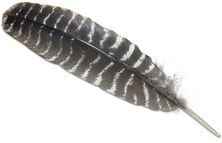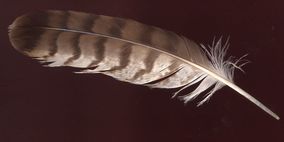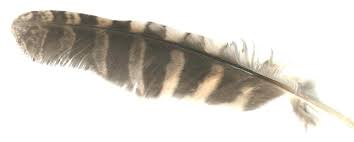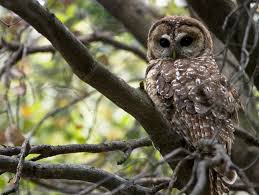
Mexican Spotted Owl
Featured Animal: July 2018
By Laura Allard and Dr. Nicki Frey
Identification and Biology
The Mexican Spotted Owl (Strix occidentalis lucida) is one of the largest owls in North America, coming in as 5th on the scale of owl size with a wingspan of approximately 43 inches, a height of 45 inches, and weight of 21 ounces! This owl exhibits sexual dimorphism with females being larger than males.
The overall appearance of the Mexican Spotted Owl is chocolate brown in color with irregularly shaped white spots forming what can look like stripes across the owl’s body. The owl’s feathers, with their stripe-like pattern can often be mistaken for hawk or turkey feathers, which have similar patterns.
Featured Animal: July 2018
By Laura Allard and Dr. Nicki Frey
Identification and Biology
The Mexican Spotted Owl (Strix occidentalis lucida) is one of the largest owls in North America, coming in as 5th on the scale of owl size with a wingspan of approximately 43 inches, a height of 45 inches, and weight of 21 ounces! This owl exhibits sexual dimorphism with females being larger than males.
The overall appearance of the Mexican Spotted Owl is chocolate brown in color with irregularly shaped white spots forming what can look like stripes across the owl’s body. The owl’s feathers, with their stripe-like pattern can often be mistaken for hawk or turkey feathers, which have similar patterns.
The amount of white in these spots tends to make the owl appear somewhat lighter in color than other spotted owls. A feature that sets them apart from other owls is their eyes, which are dark rather than yellow like many other owl species.
Mexican spotted owls do not make their own nests, preferring to use suitable sites, like a cliff, or nests made by other species. Each spring the female lays 1-4 eggs that hatch after about 30 days. Both parents assist with rearing the chicks. Chicks can die from exposure to the elements, as well as suffer predation by Great horned owls. Usually only 1-2 chicks will survive until they fledge 34-36 days after hatching.
Mexican spotted owls primarily eat rodents, but they have also been known to eat rabbits and other small mammals.
Species Habitat and Range
The range of the Mexican spotted owl extends from the southern Rocky Mountains in Colorado and the Colorado Plateau in southern Utah southward through Arizona and New Mexico and discontinuously through the Sierra Madre Occidental and Oriental to the mountains at the southern end of the Mexican Plateau. Mexican spotted owls are considered non-migratory, meaning they don’t travel larges distances between summer and winter habitats. However, they will move to lower elevations during the winter months to avoid extreme weather conditions.
Mexican spotted owls do not make their own nests, preferring to use suitable sites, like a cliff, or nests made by other species. Each spring the female lays 1-4 eggs that hatch after about 30 days. Both parents assist with rearing the chicks. Chicks can die from exposure to the elements, as well as suffer predation by Great horned owls. Usually only 1-2 chicks will survive until they fledge 34-36 days after hatching.
Mexican spotted owls primarily eat rodents, but they have also been known to eat rabbits and other small mammals.
Species Habitat and Range
The range of the Mexican spotted owl extends from the southern Rocky Mountains in Colorado and the Colorado Plateau in southern Utah southward through Arizona and New Mexico and discontinuously through the Sierra Madre Occidental and Oriental to the mountains at the southern end of the Mexican Plateau. Mexican spotted owls are considered non-migratory, meaning they don’t travel larges distances between summer and winter habitats. However, they will move to lower elevations during the winter months to avoid extreme weather conditions.
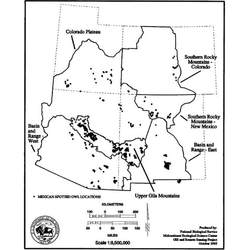
Distribution of the Mexican spotted owl in Utah, Arizona, Colorado, and New Mexico
Credit: U.S. Fish and Wildlife Service. Mexican spotted owl recovery plan, 1995
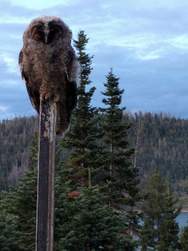
Riparian woodlands, Madrean Pine/Oak forests of Mexico’s mountain ranges, mixed-conifer forests, and rocky canyons all provide habitat for Mexican spotted owls to both nest and forage within. Throughout their range, most nests are found on high cliff faces and within high branches and hollows of coniferous trees throughout their range.
Mexican Spotted Owl Considered Threatened
The Mexican spotted owl is considered a threatened species in both the U.S. and Mexico. Mexican spotted owl populations are predicted to decline drastically over time. Unfortunately, Mexican spotted owl populations are negatively impacted by the loss, degradation, and fragmentation of their habitat due to the logging industry, property developments, agriculture, water development, and mining. In addition to human-related habitat loss, Mexican spotted owl populations are threatened by wildfires, which have increased in occurance, size and intensity throughout their range.
Because of the Mexican Spotted Owl’s small egg-clutch size, low nesting success and older age before breeding, the population size of this species is slow to recover from any negative impacts due to environmental change. In addition, it does not compete well against Barred Owls, which are encroaching into historic spotted owl habitat.
To help Mexican spotted owls maintain and increase their populations, state and federal governments protect habitat that is known to be preferred for nesting and chick rearing. Currently, the US Fish and Wildlife Service protects 8.6 million acres of federal land in Arizona, Colorado, New Mexico, and Utah known to be used by the Mexican Spotted Owl.
How to Help Manage the Mexican Spotted Owl
Your actions can help the Mexican spotted owls.
US National Park Service. 2018.The Mexican Spotted Owl. Accessed at <https://www.nps.gov/articles/mexican-spotted-owl.htm>
US Fish and Wildlife Service. 2012. The Mexican Spotted Owl Recovery Plan, First Revision. Accessed at <https://ecos.fws.gov/docs/recovery_plan/MSO_Recovery_Plan_First_Revision_Dec2012.pdf>
Utah Division of Wildlife Resources. 2018. The Mexican Spotted Owl. Accessed at <https://dwrcdc.nr.utah.gov/rsgis2/Search/Display.asp?FlNm=striocci>
Mexican Spotted Owl Considered Threatened
The Mexican spotted owl is considered a threatened species in both the U.S. and Mexico. Mexican spotted owl populations are predicted to decline drastically over time. Unfortunately, Mexican spotted owl populations are negatively impacted by the loss, degradation, and fragmentation of their habitat due to the logging industry, property developments, agriculture, water development, and mining. In addition to human-related habitat loss, Mexican spotted owl populations are threatened by wildfires, which have increased in occurance, size and intensity throughout their range.
Because of the Mexican Spotted Owl’s small egg-clutch size, low nesting success and older age before breeding, the population size of this species is slow to recover from any negative impacts due to environmental change. In addition, it does not compete well against Barred Owls, which are encroaching into historic spotted owl habitat.
To help Mexican spotted owls maintain and increase their populations, state and federal governments protect habitat that is known to be preferred for nesting and chick rearing. Currently, the US Fish and Wildlife Service protects 8.6 million acres of federal land in Arizona, Colorado, New Mexico, and Utah known to be used by the Mexican Spotted Owl.
How to Help Manage the Mexican Spotted Owl
Your actions can help the Mexican spotted owls.
- Most large wildfires in southern Utah are caused by human error. If you camp or play in your National Forests, take care of your campfire. Don’t leave it burning unattended and ensure that it is “dead out” before you are finished using that area.
- Respect their nesting habitat. In National Park and National Forests, managers may close trails to protect known spotted owl nests. Please respect these trail closings; they are only temporary. Keeping the area quiet and human-free may increase the nesting success of the spotted owls.
- If you think you see a Mexican spotted owl, take a photo of it - from a distance - and send it to [email protected]. We will send it to the management biologists to help them maintain their records of areas actively used by Mexican spotted owls.
- If you find a bird’s nest, especially an owl’s nest, leave it alone! Do not disturb the nest; take photos from a distance. We will help you identify the owners of the nest if you send us a photo.
US National Park Service. 2018.The Mexican Spotted Owl. Accessed at <https://www.nps.gov/articles/mexican-spotted-owl.htm>
US Fish and Wildlife Service. 2012. The Mexican Spotted Owl Recovery Plan, First Revision. Accessed at <https://ecos.fws.gov/docs/recovery_plan/MSO_Recovery_Plan_First_Revision_Dec2012.pdf>
Utah Division of Wildlife Resources. 2018. The Mexican Spotted Owl. Accessed at <https://dwrcdc.nr.utah.gov/rsgis2/Search/Display.asp?FlNm=striocci>
